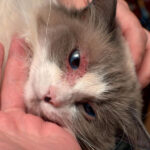Every cat owner is likely familiar with the unsettling sound of their feline friend retching, followed by the unpleasant discovery of a hairball. While seemingly disgusting, hairballs are a common occurrence in cats. But what exactly are they, why do they happen, and when should you be concerned about your Hairball Cat?
Hairballs, scientifically known as trichobezoars, are essentially clumps of undigested hair that cats cough up. Despite the name, they aren’t typically round. Instead, they often appear elongated and cylindrical, resembling a sausage or cigar. This shape is due to the narrow passage of the esophagus, the food pipe through which the hairball travels from the stomach to be expelled. However, if a hairball remains in the stomach, it can indeed form a rounder mass, much like a sponge.
These regurgitated clumps vary in size, usually around an inch long, but can sometimes reach up to five inches in length and an inch in thickness. Their color usually mirrors the cat’s coat, darkened by food and digestive fluids like bile, often giving them a greenish tinge. While unpleasant, the odor is generally tolerable.
Hairballs are a byproduct of a cat’s natural grooming behavior. Cats are meticulous groomers, and their tongues are covered in tiny, backward-facing barbs called papillae. These papillae act like a comb, effectively trapping loose hair as the cat grooms itself. This trapped hair is then swallowed. According to veterinary experts, hair itself is largely indigestible due to keratin, a tough protein. While most swallowed hair passes through the digestive system and is eliminated in feces, some hair can remain in the stomach, gradually accumulating into a damp, matted clump – the hairball.
It’s considered normal for a cat to regurgitate a hairball occasionally, perhaps once every week or two. In most cases, this is simply an inconvenience for the owner and not a cause for alarm. However, hairballs become a concern when they grow too large to pass through the sphincters leading from the esophagus to the stomach or from the stomach to the intestines. A particularly dangerous situation arises if a hairball manages to move into the small intestine and become lodged there, causing a blockage. While less common, this intestinal obstruction is a serious condition requiring veterinary intervention and can be life-threatening if left untreated.
If your hairball cat exhibits symptoms like lethargy, refuses food for more than a day, or experiences repeated unproductive retching or vomiting, it’s crucial to seek veterinary attention promptly. These signs could indicate a hairball obstruction or other serious gastrointestinal or respiratory issues, such as asthma. Diagnosing a hairball blockage involves a veterinary examination, potentially including bloodwork, X-rays, and ultrasound, along with considering the cat’s hairball history.
Treatment for a hairball obstruction may involve surgery to remove the blockage. However, in many cases, veterinarians can manage the situation with supportive care, including the use of laxatives to help the hairball pass through the digestive tract. It’s important to emphasize that laxatives should never be administered to cats without veterinary guidance. Similarly, commercially available hairball control diets and remedies should be used under veterinary supervision.
Prevention is the best approach to managing hairballs in cats. Regular grooming is key to reducing the amount of loose hair your cat ingests. Brushing your cat daily, especially long-haired breeds, can significantly minimize hairball formation. Certain diets formulated for hairball control can also be beneficial. These diets often contain higher fiber content to aid in moving hair through the digestive system. Consult your veterinarian about the best preventative strategies and dietary options for your hairball cat to ensure their health and well-being.


